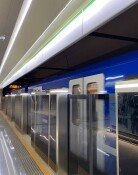Activities observed at Yongbyon facility
Activities observed at Yongbyon facility
Posted November. 24, 2018 07:35,
Updated November. 24, 2018 07:35
International Atomic Energy Agency Director-General Yukiya Amano said Thursday at a board meeting that the agency observed activities at the Yongbyon reactor facility consistent with the fabrication of reactor components and the possible transfer of these components into the reactor building. “Without access, the agency cannot confirm the nature and purpose of these activities,” he said. Back in September, North Korean leader Kim Jong Un agreed to shut down the Yongbyon nuclear facility if the United States takes corresponding measures.
Despite its offer, though there was a string attached, Pyongyang’s continuing operations at the facility is clearly intended to gain the upper hand in negotiations with Washington. By revealing its continued production of plutonium and highly-enriched uranium (HEU), the regime is staging a protest that it will not abandon its nuclear weapons unless appropriate rewards are given in response. Also, the North may want to exclude incomplete reactors from the list of reactors to be closed, claiming that they are for the “peaceful use” of nuclear energy.
The Yongbyon complex has some 390 facilities including a 5MW reactor, a reprocessing facility, and a uranium enrichment plant that produces highly-enriched uranium. Yet, they are already old and outdated, so there is even a risk of a radiation leak. It was also where the cooling tower that the North toppled in 2007 was located. North Korea, which proclaimed that its quest for nuclear weapons is complete, obviously brought up the facilities as it no longer needed them. At the same time, the regime is refusing to submit the entire inventory of its nuclear weapons.
Still, as the Yongbyon facility serves as a symbol of Pyongyang’s nuclear development, the dismantlement of the complex along with the Dongchang-ri missile test site could give a new impetus to the denuclearization process. This may be why the United States intends to continue negotiations in spite of the regime’s refusal to report its nuclear weapons. Washington has recently sent a series of messages to the North that it wants to hold talks. U.S. Vice President Mike Pence said that he would not demand for the complete declaration of the North’s nuclear inventory prior to a second North Korea-U.S. summit, and agreed on a joint study to link up the two Koreas’ railways. U.S. Secretary of Defense James Mattis also expressed an intention to scale down the annual joint military drill Foal Eagle next year.
However, North Korea is still dragging on, not providing a response to Washington’s proposal to hold high-level talks, probably out of an intention to force concessions from the United States on the lifting of sanctions. Yet, such an attitude is nothing but foolish as it only makes Kim’s sincerity towards denuclearization doubtful. North Korea should first allow international inspectors to visit the Yongbyon complex so that other parties can have confidence that “the final, fully verified denuclearization” can take place. Without trust, there can be neither rewards nor patience.







